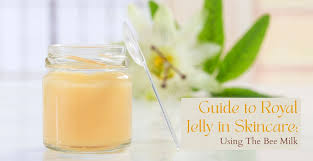
The Science of Royal Jelly in Skin Care
Royal jelly (RJ) is often considered the royal product of skin care products and is praised for its nourishing and regenerative properties.
This unique substance produced by bees has been used in traditional medicine for centuries, and its potential benefits in modern skin care have been under the spotlight for decades.
Like all skin care ingredients, royal jelly may not be suitable for all skin types or skin concerns.
Here, we explain what this popular ingredient is, what active ingredients it contains, which skin types are best suited for it, and how to incorporate it into your skin care routine.
Royal jelly is a substance produced by bees that has powerful antibacterial, anti-inflammatory and anti-aging properties.
It can be used as a rinse-off mask or a leave-on serum or cream.
People who are allergic to bees or pollen should not use royal jelly.
What is Royal Jelly?
Royal jelly is a milky, nutrient-rich secretion produced by worker bees that feeds the queen bee and the developing larvae in the hive.
This substance is the sole determinant of the queen bee’s growth, fertility, and lifespan. Queen bees feed exclusively on royal jelly and can live up to five years, while worker bees live only a few weeks. Royal jelly is used in a variety of health and beauty products because of its longevity and vitality.
In skin care, royal jelly is widely used because it is rich in vitamins, minerals, and bioactive compounds that have been shown to nourish and moisturize the skin, thereby providing powerful anti-aging effects (3).
Active Ingredients in Royal Jelly
Royal jelly is a complex substance with a unique composition that contributes to its effectiveness as a skin care product. Its main active ingredients include:
Proteins and peptides. Royal jelly contains approximately 12% to 15% protein, including key royal jelly proteins (MRJP), which have been shown to have anti-inflammatory and antioxidant properties (4). These proteins help repair and rejuvenate the skin, making royal jelly a popular ingredient in anti-aging products.
Lipids. The lipid component of royal jelly contains fatty acids such as 10-hydroxy-2-decenoic acid (10-HDA), which play an important role in its antimicrobial and anti-inflammatory effects.
These fatty acids also help maintain the skin’s natural barrier, moisturizing it and protecting it from environmental influences.
Vitamins and Minerals. Royal jelly is rich in vitamins B1, B2, B6 and B12, as well as folic acid and pantothenic acid.
These vitamins can improve skin structure, promote cell regeneration and protect against oxidative stress.
Amino Acids. The essential amino acids in royal jelly aid in the synthesis of collagen, which is essential for skin elasticity and firmness.
Therefore, royal jelly is an excellent ingredient for preventing and reducing fine lines and wrinkles.
Antioxidants: Royal jelly contains a variety of powerful antioxidants, including flavonoids and polyphenols, which can fight free radicals and reduce oxidative stress in the skin.
Benefits of Royal Jelly in Skin Care
Royal jelly is often used in skin care for its anti-aging properties, but it can also provide the following benefits to the skin:
Anti-Aging: Since royal jelly is rich in proteins, vitamins and antioxidants, it helps promote collagen production and cell renewal, thereby reducing the appearance of wrinkles and fine lines.
Moisturizing: Royal jelly’s high lipid content makes it an effective moisturizer that hydrates the skin and improves its elasticity. It is particularly beneficial for dry and mature skin.
Healing and Calming. Royal jelly’s anti-inflammatory and antibacterial properties can soothe irritated skin and promote healing.
As a result, it can be helpful for conditions such as eczema, dermatitis, and minor wounds.
Estrogenic Effects. Some studies suggest that royal jelly may have estrogenic effects that may benefit skin health, especially in postmenopausal women (5).
However, these effects are mild and not fully understood, so further research is needed to confirm these benefits.
Side Effects of Royal Jelly in Skin Care
Royal jelly is generally suitable for most skin types. However, two important side effects to consider before using products containing this ingredient are:
Allergic reactions. One of the biggest risks associated with royal jelly is the risk of allergic reactions.
People who are allergic to bee products or pollen should not use royal jelly or other bee-derived ingredients because royal jelly can cause reactions ranging from mild irritation to severe allergic reactions.
Estrogenic Effects. Although royal jelly has low estrogenic effects, women with a history of breast or ovarian cancer should consult their doctor before using products containing royal jelly.
What skin types are best for royal jelly?
Royal jelly is suitable for almost all skin types, but is particularly suitable for women with dry, mature, or sensitive skin due to its moisturizing and soothing properties.
However, people with oily skin or acne-prone skin should check the product’s ingredient list to make sure it does not contain other ingredients such as coconut oil or shea butter that may clog pores.
Royal Jelly Masks
You can apply royal jelly to your face like a mask, leave it on for 15 to 20 minutes, and then rinse it off.
Alternatively, you can use a serum or cream containing royal jelly as part of your daily skincare routine.
If you have very dry skin and also use a moisturizer, apply the moisturizer after using the royal jelly serum. Don’t forget to apply sunscreen when you apply it in the morning.
Summary: Should I Use Royal Jelly?
There is scientific evidence that royal jelly can improve skin smoothness and texture and reduce signs of aging.
However, products containing royal jelly tend to be more expensive because each beehive only produces a small amount of the raw material.
If you still want to try royal jelly, it generally has few side effects (unless you are allergic to bees or pollen) and is suitable for most skin types.
While it is not one of the best anti-aging ingredients, it is an interesting natural option for treating aging skin.


